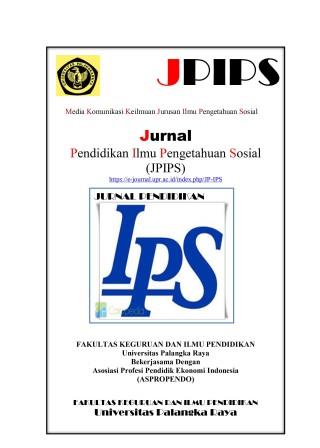Dampak Sosial Ekonomi Peternakan Ayam Kampung Berskala Mikro Di Desa Payaman, Nganjuk
DOI:
https://doi.org/10.37304/jpips.v14i1.4728Keywords:
response, impact, pollutionAbstract
This research was conducted at a local micro-scale, Mr. Junaidi's local chicken farm, Payaman Village, Payaman Village, Nganjuk Regency, from November 20 to February 18, 2022. The purpose of the study was to determine the community's response to the existence of free-range chicken farming and determine the socio-economic impact on the community around the farm. The research was conducted using qualitative methods. It collects data using direct interviews with people who live around the farm using a questionnaire and sampling technique using purposive sampling. The results showed that the community's response around the farm did not object to the existence of a community-scale free-range chicken farm as long as it did not interfere with community activities and did not cause excessive negative impacts. The social impacts that arise from the existence of a community-owned free-range chicken farm in Payaman Village consist of positive impacts such as creating new business opportunities, employment opportunities, and motivating the community. The negative impacts that arise are environmental pollution, the emergence of conflict, and competition. The economic impacts felt by the community include the positive impact in the form of additional income from a side business from selling karak nasi (dried rice) for chicken feed, opening rice stalls, and basic food shops around the coop. The cage needs attention to avoid wild animals and predators such as snakes, monitor lizards, and civets that endanger livestock and residents. Reducing odors and diseases as environmental pollution around residential areas by giving fly repellent and cleaning chicken manure is needed. The waste treatment process is also very much required; this aims to reduce disease risk and reduce environmental pollution for farming sustainability
Downloads
References
Azwar, S. (2005). Sikap Manusia: Teori Dan Pengukurannya. Yogyakarta: Pustaka Belajar.
Arif, H. (2009). Pengertian Tentang dampak, Jakarta Bandung Alfabeta.
Baron, Robert A dan Donn Byrne. (2003). Psikologi Sosial Jilid 1. Erlangga. Jakarta.
Dananjaya, I. G. (2020). DAMPAK SOSIAL EKONOMI KEBERADAAN USAHA PETERNAKAN AYAM RAS. Dwijen AGRO, Vol. 10 No. 2.
Direktorat Jendral Peternakan danKesehatan Hewan. (2018). Statistik Peternakan dan Kesehatan Hewan (Livestock and Animal Health Statistics) 2018. Jakarta: Kementerian Pertanian RI
Durkheim, E. (1984). The Internet and Society. Cambridge: Polity Press.
Dwi P., dan Rahmat. (2015). Dampak Sosial Ekonomi Dan Lingkungan Penambangan Batubara Ilegal Di Desa Tanjung Lalang Kecamatan Tanjung Agung Kabupaten Muara Enim. Jurusan Sosiolagi, Fakultas Sosial Dan Ilmu Politik: Universitas Sriwijaya.
Fardani, A. (2012). Dampak Sosial Keberadaan Pt Vale Indonesia Tbk Terhadap Kehidupan Masyarakat (Studi Kasus Sorowako Kecamatan Nuha Kabupaten Luwu Timur). Universitas Hasanuddin: Jurusan Sosiologi FISIP.
Funk, E.A. (2007). The pygmy hog is a unique genus: 19th century taxonomists got it right the first time round. Molecular Phylogenetics and Evolution, Volume 45: 427-436.
Febri Erik Yudi Kha, Tonich Uda, Sri Rohaetin, Rinto Alexandro, Dehen Erang. (2021). Manfaat Sosial Ekonomi Budidaya Sarang Burung Walet Bagi Masyarakat. Jurnal Ilmu Ekonomi dan Sosial. Vol. 12 no. 2. Hal. 64-77. http://ejournal.unmus.ac.id/index.php/ekosos/article/view/3935
KBBI Online. (2010). Kamus Besar Bahasa Indonesia (http://www.depsos.go.id
Lase, J. A., dan Lestari, D. (2020). Potensi Ternak Entok (Cairina Moschata) Sebagai Sumber Daging Alternatif Dalam
Marta, A. (2016). Potret Konflik Sosial Di Kabupaten Kuantan Singingi Tahun 2013. Nakhoda: Jurnal Ilmu Pemerintahan, 13(1), 44
Murtijo, B.A. (1987). Pedoman Beternak Ayam Broiler. Jakarta: Kanisius.
Page, M. I. (2006). Communication, Technology and Politics in the Information Age. Sage Publications.
Safril, E. (2010). Dampak Sosial Keberadaan Usaha peternakan Ayam Ras Dan Petelur Pada Wilayah Pemukiman Kabupaten Lima Puluh.
Sailindra. (2017). Budidaya Ayam Potong.Yogyakarta: Zahara.
Santoso, U. (2010). Dampak Usaha Peternakan Ayam Broiler. https://uwityangyoyo.wordpress.com/2010/09/28/dampak-usahapeternakan-ayam-boiler/. (Diakses pada Tanggal 10 Juli 2020).
Saptana. (2012). Kelembagaan kemitraan usaha dalam mendukung agribisnis unggas lokal yang berkelanjutan. Dalam: Iskandar S, Resnawati H, Priyanti A, Sartika T, Damayanti R, penyunting. Pengembangan Peran Unggas Lokal dalam Industri Perunggasan Nasional. Prosiding Workshop Nasional WARTAZOA Vol. 26 No. 4 Th. 2016 Hlm. 191-202 202 Unggas Lokal. Jakarta, 5 Juli 2012. Bogor (Indonesia): Puslitbangnak. hlm. 43-54.
Sumantri. (2008). Pembuatan pupuk kompos super dengan teknologi EM4. Pros. Lokakarya Fungsional Non Peneliti. Pusat Penelitian dan Pengembangan Peternakan, Badan Penelitian dan Pengembangan Pertanian. hal. 118-120.














